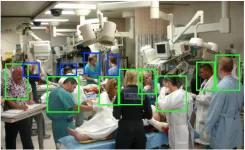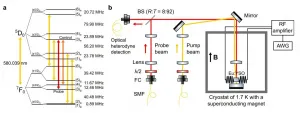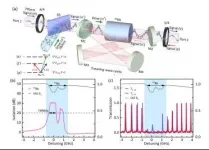(Press-News.org) Twenty dollars a month might not seem like a lot to pay for health insurance. But for people getting by on $15,000 a year, it's enough to make some drop their coverage - especially if they're healthy, a new study of Medicaid expansion participants in Michigan finds.
That could keep them from getting preventive or timely care, and could leave their insurance company with a sicker pool of patients than before, say the researchers from the University of Michigan and University of Illinois Chicago. They have published their findings as a working paper through the National Bureau of Economic Research, ahead of publication in the American Journal of Health Economics.
The study has implications for other states that require low-income people to pay for their Medicaid coverage, or may be considering such a requirement if they expand Medicaid. It also has importance for the plans sold on the national and state Marketplaces to people who buy their coverage directly.
Impact of monthly fees
The new findings come from Michigan's Medicaid expansion program, called the Healthy Michigan Plan, which was one of the first in the nation to require some low-income participants to pay monthly fees and most participants to pay co-pays for services they receive. Nearly 906,000 Michiganders get their health coverage through the program.
Fees, formerly called contributions and similar to the monthly premiums that people with other forms of insurance pay, are only charged to those have a household income above the federal poverty level. The program is open to adults making up to 138% of the federal poverty level, a cap of about $17,700 for a single-person household in 2021.
The analysis was done by a team from the U-M Institute for Healthcare Policy and Innovation, which has conducted a formal evaluation of the program for the Michigan Department of Health and Human Services. Betsy Q. Cliff, Ph.D., now at the University of Illinois Chicago, led the analysis during her doctoral training at the U-M School of Public Health.
While people leave Medicaid for a number of reasons, the study found a 2.3 percentage point jump in disenrollment at the federal poverty level, which the researchers attribute to the imposition of premiums.
Given a baseline disenrollment of about 20% over 6 months of the program, the study finds 12% more participants dropped off the Healthy Michigan Plan after they began owing monthly fees. The amount someone had to pay also mattered: Disenrollment rose by nearly 1 percentage point for every dollar charged monthly. The study used data from the inception of the program in March 2014 and followed participants through September 2016.
Michigan's cost-sharing requirements for people in the Healthy Michigan Plan kick in after a person has been in the program for six months. An individual on the program with an income just above the poverty level - around $12,900 a year in 2021 - might be charged about $20 a month, though this amount can be reduced by engaging in a discussion with their physician about healthy behaviors. The monthly amount goes up as income increases.
"Disruptions in Medicaid coverage -- also known as churn -- can lead to worse quality care, higher administrative costs and less chance for the population to receive needed but non-urgent preventive services," says Cliff, now an assistant professor at UIC's School of Public Health.
Indeed, previous work by the IHPI team to survey past participants in the Healthy Michigan Plan showed that 81% had access to no other form of insurance before they joined the program, and that 55% went uninsured for the three months after they left it.
Signs of "adverse selection"
When the researchers looked closer at who was leaving the plan, they found that it was mainly people who were relatively healthy: Those who hadn't had any care related to a chronic illness, and that had below-median health spending.
By contrast, the study did not find an increase in disenrollment among those who had gotten care for a chronic condition or had above-median health care spending during the first months after enrollment, before they received a cost-sharing invoice.
In participants who had no care related to a chronic disease in the six months before cost-sharing kicked in, or who had below-median overall spending, facing a premium increased the chance of disenrollment by about 3 percentage points. Every dollar of monthly fees cost raised disenrollment by 0.8 percentage points. But monthly fees didn't change the disenrollment chances of less-healthy enrollees who had chronic disease care or higher-than-median health spending.
When the researchers adjusted for demographic differences, they found that the people who disenrolled had medical spending in the first six months of enrollment that was 40% lower than the spending for those who stayed in.
Being billed for co-pays did not seem to alter the chance that people of any health status would leave the program. In general, co-pays for people receiving certain health care services under the Healthy Michigan Plan are $1 to $8 for a prescription up to $100 for an inpatient hospital stay, depending on income.
Enrollees are not required to leave the program for non-payment of monthly fees or co-pays; people must actively disenroll or fail to complete yearly renewal paperwork.
Implications for other states and plans
In addition to the disruption for individuals and the private plans that cover them, the authors say the findings have implications for how the state and federal governments plan for spending on Medicaid, and how they adjust payments to insurers and providers based on patients' health risk.
States that are considering implementing or continuing cost-sharing requirements under Medicaid expansion should consider this, the authors say.
Cost-sharing is seen as a way to promote personal responsibility and encourage participants to make better decisions about health care and have been used as a way to achieve bipartisan support for Medicaid expansion in Michigan and other states.
But as the study shows, this may limit access to coverage and cause Medicaid to experience adverse selection, that can disrupt the health insurance market.
INFORMATION:
The paper's senior author is Richard Hirth, Ph.D., the S.J. Axelrod Collegiate Professor of Health Management and Policy at the U-M School of Public Health. IHPI director John Z. Ayanian, M.D., M.P.P., who leads the institute's evaluation of the Healthy Michigan Plan and is the Alice Hamilton Distinguished University Professor of Medicine and Healthcare Policy at the Medical School with joint appointments at SPH and the Ford School of Public Policy, is a co-author. In addition to Cliff, Hirth and Ayanian, the study's authors are Sarah Miller of the U-M Ross School of Business, and Jeffrey Kullgren of the U-M Medical School.
To learn more about the IHPI evaluation of the Healthy Michigan Plan, and see previous reports, announcements and papers it has generated, visit https://ihpi.umich.edu/featured-work/hmp
DURHAM, N.C. - A potential new vaccine developed by members of the Duke Human Vaccine Institute has proven effective in protecting monkeys and mice from a variety of coronavirus infections -- including SARS-CoV-2 as well as the original SARS-CoV-1 and related bat coronaviruses that could potentially cause the next pandemic.
The new vaccine, called a pan-coronavirus vaccine, triggers neutralizing antibodies via a nanoparticle. The nanoparticle is composed of the coronavirus part that allows it to bind to the body's cell receptors and is formulated with a chemical booster called an adjuvant. ...
A Flinders University researcher has finally fathomed why large numbers of killer whales gather at a single main location off the Western Australian southern coastline every summer.
In a new paper published in Deep Sea Research, physical oceanographer Associate Professor Jochen Kampf describes the conditions which have produced this ecological natural wonder of orcas migrating to the continental slope near Bremer Bay in the western Great Australian Bight from late austral spring to early autumn (January-April).
"The aggregation is connected to the local marine food web that follows from the upwelling of benthic particulate organic matter (POM) ...
A novel approach to immunotherapy design could pave the way for new treatments for people with an aggressive form of brain cancer called glioblastoma.
Using specifically designed receptors, researchers were able to completely clear brain cancer tumours in preclinical models, using chimeric antigen receptor (CAR) T cell therapy.
Published today in Clinical & Translational Immunology and led by Associate Professor Misty Jenkins, the research is a crucial step towards developing new immunotherapy treatments for this devastating illness.
More than 1800 Australians are diagnosed with brain cancer every year. ...
A new micro-light-emitting diode (micro-LED) developed at KAUST can efficiently emit pure red light and may help in the quest to develop full-color displays based on just a single semiconductor.
Micro-LEDs are a promising technology for the next generation of displays. They have the advantage of being energy efficient and very small. But each LED can only emit light over a narrow range of colors. A clever solution is to create devices that combine many different LEDs, each emitting a different color. Full-color micro-displays can be created by combining red, green and blue (RGB) micro-LEDs. Now, a KAUST team of Zhe Zhuang, Daisuke Iida and Kazuhiro Ohkawa have worked to develop ...
SAN FRANCISCO, CA (May 10, 2021) -- The Gulf of Guinea islands harbor an abundance of species found nowhere else on Earth. But for over 100 years, scientists have wondered whether or not a population of limbless, burrowing amphibians--known as caecilians--found on one of the islands is a single or multiple species. Now, a team of researchers from the California Academy of Sciences and the Smithsonian National Museum of Natural History has contributed the strongest evidence to date that there is not one, but two different species of caecilians on São Tomé ...
Computer scientists at the University of California San Diego have developed a more accurate navigation system that will allow robots to better negotiate busy clinical environments in general and emergency departments more specifically. The researchers have also developed a dataset of open source videos to help train robotic navigation systems in the future.
The team, led by Professor Laurel Riek and Ph.D. student Angelique Taylor, detail their findings in a paper for the International Conference on Robotics and Automation taking place May 30 to June 5 in Xi'an, China.
The project stemmed from conversations with clinicians over several years. The consensus was that robots would best help physicians, nurses and staff ...
An international team led by researchers from the Xinjiang Institute of Ecology and Geography (XIEG) of the Chinese Academy of Sciences and the University of Geneva has found that flash floods may triple across the Earth's "Third Pole" in response to ongoing climate change.
Their findings were published in Nature Climate Change on May 6.
The Hindu Kush-Himalaya, Tibetan Plateau and surrounding mountain ranges are widely known as the "Third Pole" of the Earth. It contains the largest number of glaciers outside the polar regions.
Due to global warming, the widespread and accelerated melting of glaciers over ...
Remote quantum distribution on the ground is limited because of the loss of photon in optical fibers. One solution for remote quantum communication lies in quantum memories: photons are stored in the long-lived quantum memory (quantum flash drive) and then quantum information is transmitted by the transportation of the quantum memory. Given the speed of aircrafts and high-speed trains, it is critical to increase the storage time of the quantum memories to the order of hours.
In a new study published in Nature Communications, a research team led by Prof. LI Chuanfeng and Prof. ZHOU Zongquan from University of Science and Technology of China (USTC) extended the storage time of the optical memories to over one hour. It broke the record of one minute achieved by German researchers in 2013, ...
Chinese researchers achieved 51.5dB nonreciprocal isolation in the atomic ensemble, which is the highest isolation ratio in the non-magnetic nonreciprocal field. They discussed the quantum noise problem in nonreciprocal devices for the first time.
The result was published on Nature Communications on April 22, 2021.
Nonreciprocity is an important basic concept in the optical field. The isolators and circulators derived from it are all indispensable components in the optical path. Faraday isolator based on circular birefringence of magneto-optical effect is widely used because of its easy construction, high isolation and low loss.
However, in the integrated optical path, the traditional faraday isolator is subject to various limitations. ...
COLUMBUS, Ohio - Watching meaningful films - those that we find moving and poignant - can make us feel more prepared to deal with life's challenges and want to be a better person, a new study found.
The findings point to one reason why people may choose to see movies that make them sad as well as happy and that may explore difficult subjects that aren't always uplifting.
Researchers found that when people recalled watching meaningful films like The Shawshank Redemption and Up, they reported a variety of positive reactions, such as being better able to accept the human condition and make sense of problems in life.
Those positive experiences were less likely to be reported when people thought about watching Hollywood fare like The Big Lebowski or Catch Me ...






